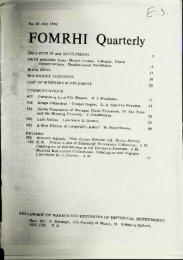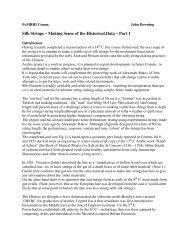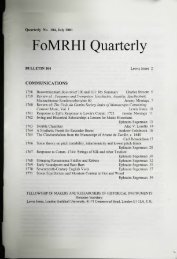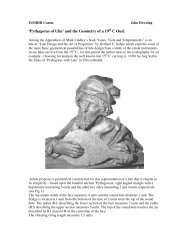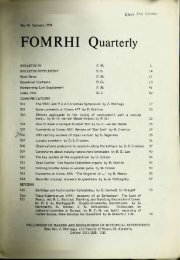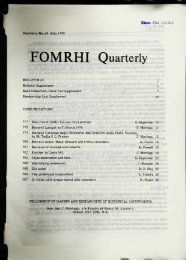•rf - FoMRHI
•rf - FoMRHI
•rf - FoMRHI
Create successful ePaper yourself
Turn your PDF publications into a flip-book with our unique Google optimized e-Paper software.
<strong>FoMRHI</strong> Com. 32<br />
BUSHIUO AS AH ALTK3HATI75 TO BOHIIIG<br />
Paul Hailperin<br />
In making woodwind inatrumenta of liuropean art music, it<br />
is general practise to first bore through the length of a<br />
piece with a tool the size of, or slightly smaller than the<br />
minimum diameter of the de9ired finished bore. For a conical<br />
bore instrument, thia pilot hole is then gradually widened<br />
with other boring tools and/or reamera. Unfortunetely, boring<br />
toola may wander, i.e. they do not neceaearily follow the axis<br />
of rotation, and thia problem becomes more aerioua, the larger<br />
the ratio of length to diameter becomea. The moat difficult<br />
inatrument in thia reBpect that I know of ia the alto ahawm,<br />
which typioelly haa a length of about 750 mm and a bore of<br />
4 mm.<br />
Hikolaus Hernoncourt has repeatedly suggested to me that<br />
renaiaaance makera might hava produced the initial bore by<br />
burning, presumably with a metal rod haated tt one end and<br />
thruat into the wood. I found the notion bisarre, until I<br />
tried it a short time ago. Accordingly I would like to report<br />
that it i_s fauaible to burn a pilot bore, ana I would give a<br />
few details of my experience.<br />
The inatrumenta I set out to make were to be raodelled on<br />
No. 8562 of the Kunsthistoriaches lluaeum In Vienna. Thia in<br />
atrument formerly belonged to the collection of the Catajo<br />
caatle, and ia to my knowledge a unique specimen of its type.<br />
It ia a deacant ahawm in d', but much ahorter than a typical<br />
-ZI-





